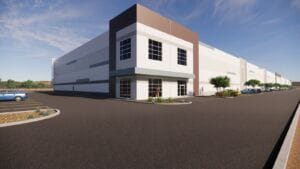Colliers International – one of the leading, global real estate services firms – just released a Top 10 Emerging U.S. Industrial Markets Report, which features Phoenix as a market to watch in 2018.
A few key reasons that Phoenix was chosen, as identified by Colliers, include:
- The Phoenix industrial market continues to post exceptional growth because of its proximity to a growing population, a strong workforce base, an expanded and modernized highway system and more attractive rental rates compared to markets in Southern California.
- Phoenix recently expanded its local interstate system, and its location along Interstate 10 gives the market a significant logistical advantage in reaching the Southwest populace.
- Activity skyrocketed in 2017 as many large tenants took advantage of the market’s growing population, economic rental rates and significant logistics advantages.
“The momentum that built in the Greater Phoenix industrial market the past few years is forecast to carry over into 2018,” said Bob Mulhern, senior managing director for Greater Phoenix. “Demand is robust in the Valley because of the area’s many logistics advantages, a strong economy and a growing population. Net absorption has been quite strong for the past several years and hit an all-time record in 2017. This robust tenant demand is fueling new development. With vacancy at a 10-year low, spec and build-to-suit projects continue to work their way through the development pipeline.”
Here’s what the report says about Phoenix:
KEY STRENGTHS:
The Phoenix industrial market continues to post exceptional growth because of its proximity to a growing population, a strong workforce base, an expanded and modernized highway system and more attractive rental rates compared to markets in Southern California. Nearly five million people live in the metro Phoenix area, the 12th highest in the U.S., and this number is expected to grow over 8% in the next five years according the U.S. Census Bureau.
LOGISTICS DRIVER:
Phoenix recently expanded its local interstate system, and its location along interstate 10 gives the market a significant logistical advantage in reaching the Southwest populace. The Phoenix Sky Harbor International Airport is a burgeoning air cargo hub utilized by both FedEx and UPS that ranked 18th in the country in total cargo in 2016.
VACANCY:
The Greater Phoenix market was one of the hardest hit by the subprime mortgage collapse and subsequent recession with overall vacancy rates topping out at 16.6% in 2009. Vacancies have declined every year since thanks to strong activity and finished 2017 at 8%, 1.4 percentage points lower than the previous year and the lowest overall vacancy rate in over a decade.
ABSORPTION:
Activity skyrocketed in 2017 as many large tenants took advantage of the market’s growing population, economic rental rates and significant logistics advantages. The region is competing and winning against other southwest U.S. markets for large tenants including Huhtamaki North America and Chewy.com which selected the region to occupy large industrial facilities in 2017. These deals, along with a plethora of other transactions, created over 9.2 million square feet of net absorption in 2017, the most in over a decade.
DEVELOPMENT:
While the pace of post-recession development peaked in 2013, a robust 5.6 million square feet were completed in 2017. Despite a significant amount of activity, under construction product dropped in the region to 3.4 million square feet at year-end, the lowest since 2013. Because of this drop in available product from new development, vacancies will continue to decline in the coming year.
ASKING RENTS:
Asking rents have trended higher over the past five years, with annual growth averaging more than 3% over that time period. In 2017, asking rents rose over 2% compared with the previous year finishing at $6.82 NNN. With vacancies projected to further decline in 2018, asking rents will continue to increase making the market even more attractive to institutional investment in the coming year.



